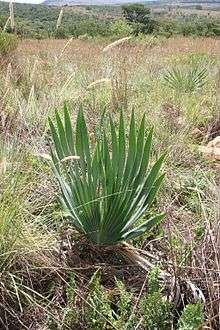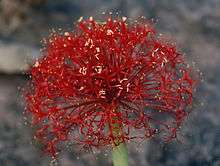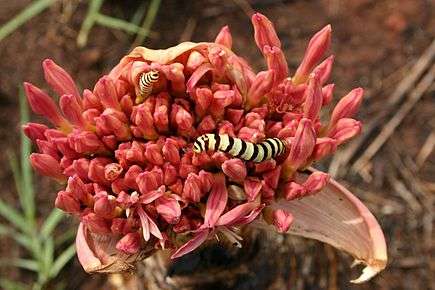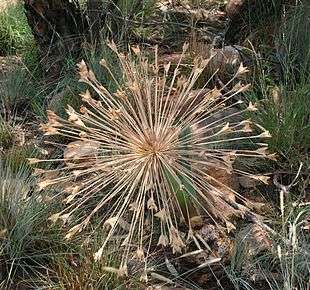Boophone disticha
Boophone disticha is a bulbous tropical and subtropical flowering plant, endemic to Africa. Commonly called the century plant[4] or tumbleweed,[3] Boophone disticha was first collected in 1781 from South Africa by Swedish botanist Carl Peter Thunberg and described by Linnaeus as Amaryllis disticha.[2] Since that time it has been placed in the genera Brunsvigia and Haemanthus, finally coming to rest as Boophone. The genus itself was written in three ways (Boophone, Boophane and Buphane) by the author William Herbert, straining the procedures of the rules of nomenclature. The etymology of the genus is from the Greek bous = ox, and phontes= killer of, a clear warning that eating the plant can be fatal to livestock.[5]
| Boophone disticha | |
|---|---|
 | |
| Habitat | |
 | |
| Inflorescence of Boophone disticha | |
| Scientific classification | |
| Kingdom: | |
| (unranked): | |
| (unranked): | |
| Order: | |
| Family: | |
| Subfamily: | |
| Genus: | |
| Species: | B. disticha |
| Binomial name | |
| Boophone disticha | |
| Synonyms[1][2][3] | |
| |
The genus as currently understood includes two or possibly three species. B. disticha is one of the most widely distributed bulbous species in South Africa, readily identified by its fan-like appearance and its bulb half-protruding from the ground. The Khoi, Bushmen and Bantu were aware of its poisonous nature and used parts of the plant medicinally and as an arrow poison. The principal compounds are eugenol - an aromatic, volatile oil smelling of cloves and having analgesic properties, and the toxic alkaloids buphandrin, crinamidine and buphanine, the latter having an effect akin to that of scopolamine and if taken in quantity may lead to agitation, stupor, strong hallucinations and (if over-ingested) coma or death.[6]
This species produces a single inflorescence before the arrival of the season's new leaves. While maturing the fruiting head's pedicels undergo a stiffening process and remarkable elongation to some 300mm. When the fruiting head separates at its junction with the stalk, it is easily moved by light breezes, scattering seeds as it rolls.
Native distribution and habitat
Boophone disticha is native to Angola, Botswana, Burundi, the Democratic Republic of the Congo, Kenya, Lesotho, Malawi, Mozambique, Namibia, Rwanda, South Africa (in the provinces of Eastern Cape, Free State, Gauteng, KwaZulu-Natal, Limpopo, Mpumalanga, Western Cape), Swaziland, Tanzania, Uganda, Zambia, and Zimbabwe.[1] It grows wild in dry savannas, grasslands, and glades in forests.[3]
Uses
Boophone disticha has been used locally to make poison for arrow's tips, and in the treatment of equine piroplasmosis.[7][8]
The bulb has a wide range of uses in traditional African medicine.[9] It contains alkaloids such as lycorine, buphanine, buphanitine and buphanidrine which have analgesic and hallucinogenic properties.[8]
Material from this species' bulb was associated with preservation of the Khoi Kouga mummy found in the Langkloof.
References
- Under its treatment as Boophone disticha (from its basionym Amaryllis disticha) this plant name was first published in Botanical Magazine 52: sub t. 2578. 1825. "Boophone disticha". Germplasm Resources Information Network (GRIN). Agricultural Research Service (ARS), United States Department of Agriculture (USDA). Retrieved November 10, 2011.
- Amaryllis disticha, the basionym of Boophone disticha, was originally described and published in Supplementum Plantarum 195. 1781. "Name - !Amaryllis disticha L.f." Tropicos. Saint Louis, Missouri: Missouri Botanical Garden. Retrieved November 10, 2011.
- Mark Hyde, Bart Wursten and Petra Ballings (2002 onwards). "Species information: Boophone disticha". Flora of Zimbabwe. Retrieved November 10, 2011. Check date values in:
|date=(help) - Medicinal and Poisonous Plants of Southern and Eastern Africa - John Mitchell Watt, and Maria Gerdina Breyer-Brandwijk (1962)
- Archer, R. H; Snijman, D. A; Brummitt, R. K (2001). "(1478) Proposal to Conserve the Name Boophone Herbert with That Spelling (Amaryllidaceae)". Taxon. 50 (2): 569. doi:10.2307/1223904. JSTOR 1223904.
- http://het.sagepub.com/content/20/5/277.abstract
- James A. Duke. "Boophone disticha (LILIACEAE)". Dr. Duke's Phytochemical and Ethnobotanical Databases. Retrieved November 10, 2011.
- Neuwinger, Hans Dieter (1996). African Ethnobotany: Poisons and Drugs : Chemistry, Pharmacology, Toxicology. pp. 10–16. ISBN 9783826100772.
- 'Medicinal and Poisonous Plants of Southern and Eastern Africa' - Watt & Brandwijk (1962)
External links
![]()
- Dressler, S.; Schmidt, M. & Zizka, G. (2014). "Boophone disticha". African plants – a Photo Guide. Frankfurt/Main: Forschungsinstitut Senckenberg.

